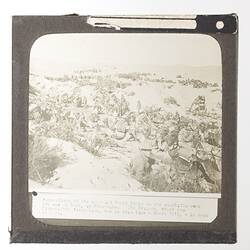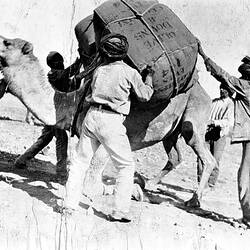Summary
Lantern slide depicting the Imperial Camel Corps at rest on the sandhills at Rafa, in Palestine. The Brigade was five-eights Australian.
Description of Content
Photograph of soldiers sitting down amongst the sparce foliage in the sand. They stretch far back into the distance. A camel sits amongst them on the lower right. Some of the soldiers wear packs and ammunition belts, suggesting they are on the march.
Physical Description
Glass plate lantern slide, square, with a wooden frame, and a type-written inscription imprinted to the image at the bottom.
Significance
The Imperial Camel Corps (or ICC) was formed in January 1916. They were recruited from a number of Australian Infantry Batallions recuperating after Gallipoli. Four batallions were formed consisting of two Australian, one British and one a mixture of Australian and New Zealanders. They were formed to deal with the revolt of pro-Turkish Senussi tribesmen in Egypt's Western Desert. The camels themselves were recruited almost solely from New South Wales, although the men came from all states. The battalions fought alongside the Australian Light Horse Units at sites such as Romani, Magdhaba and Rafa. The ICC was integral to the British war effort until June 1918, when it was largely disbanded and the Australians re-assigned to the 14th and 15th Light Horse regiments. The members of the Camel Corps were seen as rough characters, and when it was first formed many commanders found it an opportunity to offload some of their less desireable members. They were however a resourceful and effective company. The ICC kept their fellow soldiers, especially those of the Light Horse in feed and water. Often they would carry goods 80 kilometers to their destinations.
More Information
-
Collection Names
-
Collecting Areas
-
Place & Date Depicted
-
Format
Lantern Slide, Standard (3¼ in. x 3¼ in.), Black & White
-
Inscriptions
Typed inscription: 'Australians of the Imperial Camel Corps on the sandhiils near the sea at Rafa, in Palestine. The Brigade, whoch was five-eights Australian, was at this time - March 1918, - in rest at Rafa.'
-
Classification
-
Category
-
Discipline
-
Type of item
-
Overall Dimensions
82 mm (Width), 82 mm (Height)
-
References
[Link 1] viewed 13.05.2009. [Link 2] viewed 13.05.2009. Rose, Jack, 'Diary of a Light Horseman 1915-1919', Kevin Rose: Hillston, N.S.W., (2005).
-
Keywords
Military History, Soldiers, Wars & Conflicts, World War I, 1914-1918, Lantern Slides



